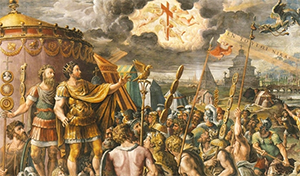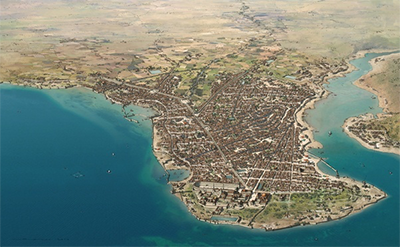The Rise and Fall of the Roman Empire
Part 8: From West to East Constantinus became Constantius I, and his son joined him as the new emperor went on campaign in Britain. The Roman Army fought against the Picts beyond Hadrian's Wall for a the better part of a year. On July 25, 306, Emperor Constantius died. One of his last proclamations was to declare his desire for his son to succeed him as Emperor in the West. Roman troops in Britain and Gaul approved this acclamation. Naming himself Emperor Constantine, he led his troops in a series of successful actions against the Picts. Once the frontier in Britain was secure again, he went to Gaul, where he led more troops to more victories, this time over the Franks. Rome had other ideas about who was emperor, however, naming as the next Augustus in the West not Constantine but Severus. He was already Caesar and so took the next step, as presumably Diocletian had wished it. Also stepping into the succession fray was Maxentius, Maximian's son, who proclaimed himself emperor in October 305. It was at this time that the aging Diocletian emerged from his retirement to try to forestall any further bloodshed. He was unsuccessful, and the civil war continued. 
In the end, it came down to a battle between Maxentius and Constantine. Maxentius had a large number of soldiers in his army. In fact, he had nearly twice as many men as Constantine had fighting for him. What Maxentius and his men saw when Constantine and his men entered the fray on October 28, 312, at the Battle of the Milvian Bridge was that, at Constantine's direction, his men had marked their shields and standards with a strange symbol, a combination of an X and what looked to be the letter P. This was, in fact, the Chi-Rho, a symbol associated with Jesus, and Constantine later said that he had a vision in which he was directed to so adorn his men's equipment. Thus equipped and accompanied, Constantine's men scored a major victory, driving the men of Maxentius and even the great commander himself into the Tiber River. Among the mass of flailing arms and legs, Maxentius died, as did a great many of his soldiers. (He later had built in Rome a triumphal arch to commemorate this victory.) As it appeared to have turned out, Maxentius, not Constantine, was "the enemy of the Romans." The following day, Constantine entered Rome in a triumphal procession. He declared all laws enacted by Maxentius void and disbanded both the Praetorian Guard and the Imperial Horse Guard. Firmly in control of the Western half of the Empire, Constantine set about removing Maxentius's name from the record books and from the sides of buildings, rededicating buildings in his own name. In 313, he met Licinius in Milan and cemented their alliance. The emperors also jointly issued the Edict of Milan, which outlined a policy of tolerance for Christianity and all other religions. This was a nearly complete reversal from the persecutions of Christians ordered by Diocletian just a few years before. Again, the peace did not last. Again, the two co-emperors came to blows, in 324 at the Battle of Adrianople, and at the Battle of the Hellespont and at the Battle of Chrysopolis. Constantine emerged the victor and accepted Licinius's surrender with a vow to letting him live in peace as long as he kept the peace. The very next year, Constantine found evidence of yet another plot against him by Licinius and ordered the latter arrested and then executed. 
Finally alone at the top, Constantine chose as his new capital Byzantium, an older Greek city. He renamed it Constantinopolis (in English "Constantinople"), and this became one of the world's great cities. He ordered a grand building and rebuilding program, repairing damaged walls and buildings and installing cisterns and other relative comforts. In his new headquarters he ordered built a large Christian church, the Church of the Holy Apostles, along with temples to the gods of other religions and many statues of famous generals like Alexander the Great, Julius Caesar, Augustus, Diocletian. Constantine did not miss the opportunity to have erected statues of himself. He organized a major gathering of Christian religious figures at the Council of Nicaea in 325. Out of that council came some major agreements on doctrine that reverberated throughout the Christian world. One of these, the Nicene Creed, is a staple of many Christian worship services to this day. The famed emperor died in 337; his three surviving sons succeeded him as joint rulers of the Empire. His and their successors ruled over a divided empire. Theodosius I, who died in 395, was the last emperor to rule over both East and West, and that was for a short time only. The mid-4th Century emperor Julian had successes in battle against German tribes in Gaul but died in fighting in Persia. A large-scale invasion in 378 prompted the emperor Valens to assemble a large force and confront a large group of Alans, Goths, and Huns at Adrianople. Valens himself was one of the great many Roman casualties resulting from the cataclysm. Theodosius turned the tide back briefly but wasn't on the throne long enough to consolidate his gains. Next page > The End of a Very Long Era > Page 1, 2, 3, 4, 5, 6, 7, 8, 9 |
|
Social Studies for Kids
copyright 2002–2025
David White




